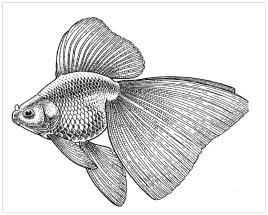Goldfish Standard for Veiltail
The Veiltail is a round bodied fish; it has a pair of anal, ventral and pectoral fins. The dorsal fin should be fully upright on the body; its height about 3/4 of the depth of the body. In the best specimens the length of the caudal fin is same to twice of the length of the body. The distinguishing feature—the characteristic that make the Veiltail different from other fish—is the finnage; the fins can be seen flowing around the fish when it swims, giving the impression that the fish is gliding in the water. The body of the Veiltail is round, almost as round as a ball, and is very compact.

Drawing of Standard English Veiltail
Veiltails are 5 to 6 inches long; the body should be round with an arch to the back. If body has a hump the fish is a hybrid by crossing of a Veiltail and a Ryukin—neither a Veiltail, nor a Ryukin. A Veiltail with a hump should be marked down when judging. Alternatively, entering the crosses of Veiltail and Ryukin in the “other” category (in other categories) other than Veiltail or Ryukin might result in higher placement.
The most important characteristic of Veiltail is its finnage. Its dorsal fin should be upright and with little or no bending. Although a slight bending of the dorsal fin is allowed, pronounced bending should be marked down. The height of the dorsal fin two to three times the depth of the body is not uncommon. The caudal fin should be long and flowing. The length of the caudal fin is two to three times the length of the body. The edges of the caudal fin should be straight; pronounced forking should be marked down. The length of the caudal fin should be two to three times the length of the body.
Metallic coloration of red, orange and blue-silver are the colors most common in Veiltails. Single coloration is normally seen in Veiltails. But there are also Calico Veiltails, the coloration follows the same rules as other varieties of Veiltails.
Veiltail can have problems in swimming because of the position of the air bladder in the body. Abnormal swimming motion is considered a conformation issue.
Please click here to discuss the standard of Veiltail





